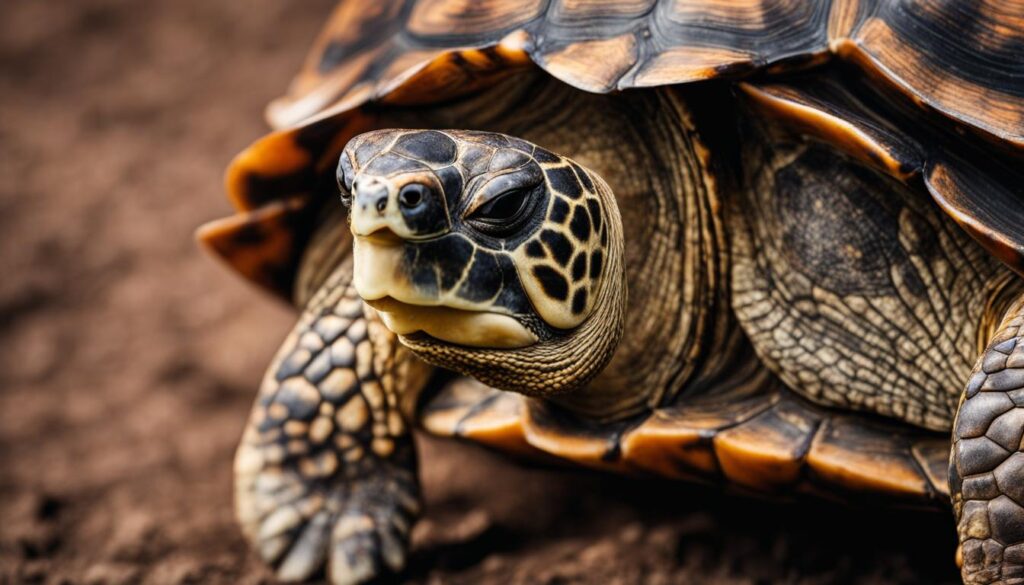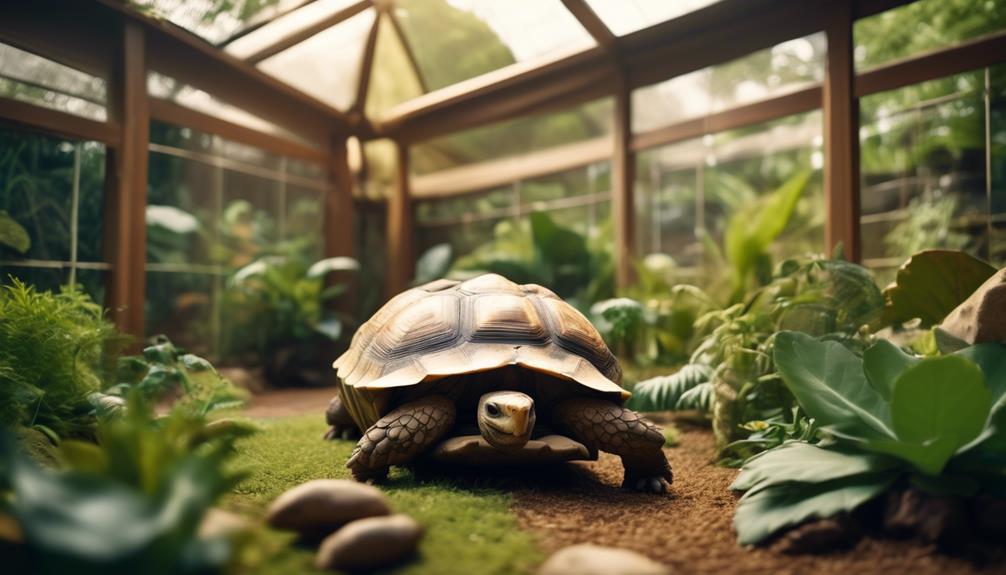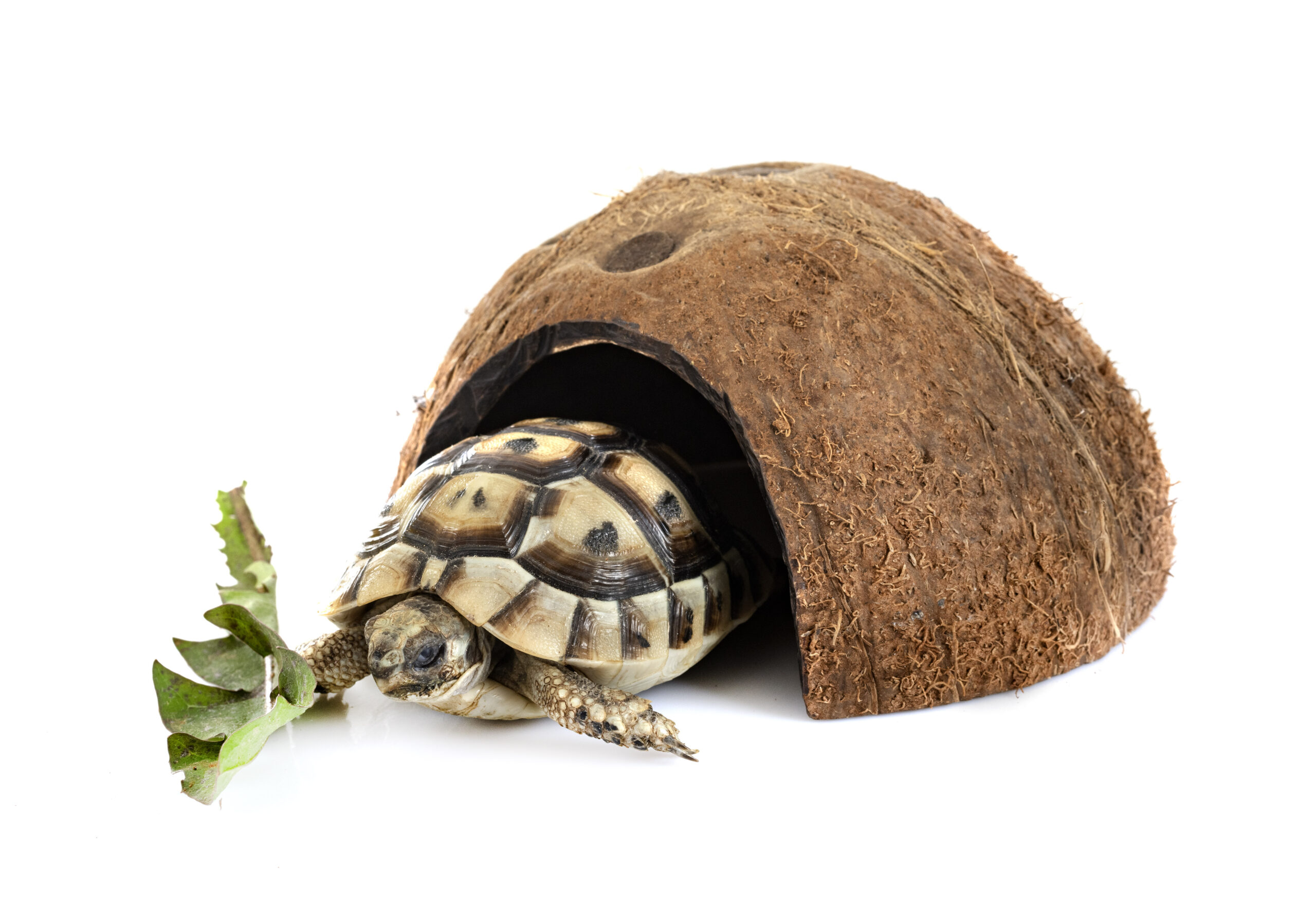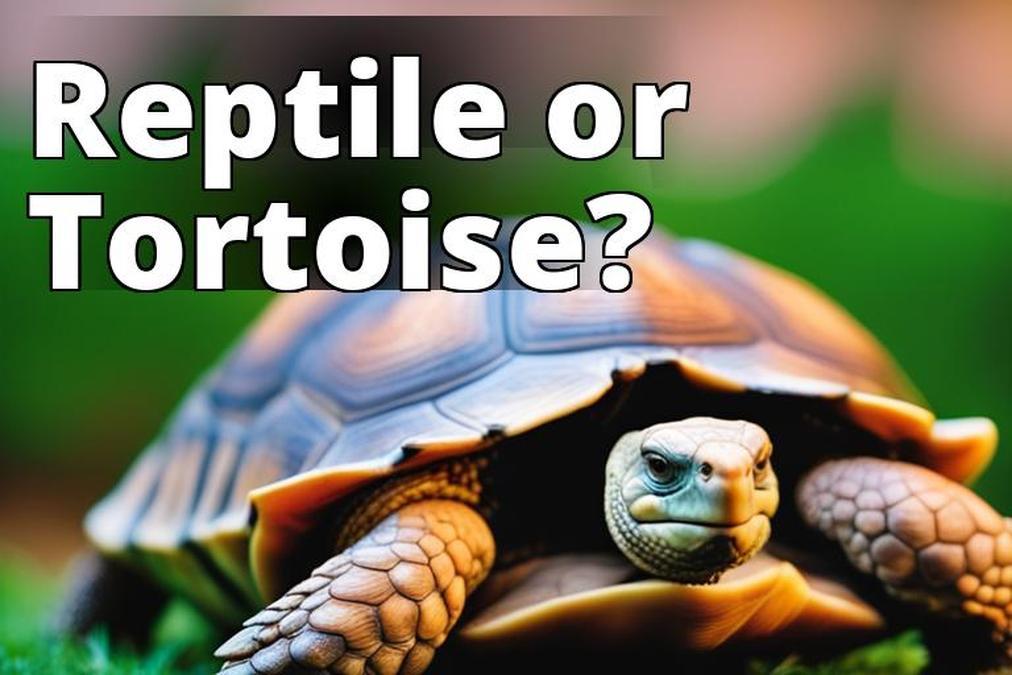Are you considering keeping a tortoise as a pet? One of the questions you might have is can a tortoise live outside. The good news is, yes, tortoises can live outside and thrive in outdoor environments with the right care and conditions. In this article, we will guide you through the essentials of tortoise care, including their outdoor living needs.
Whether you have a garden or a spacious yard, providing a suitable outdoor space for your tortoise can offer many benefits. Tortoises are generally adapted to live in outdoor habitats and enjoy the natural elements, including sunlight and fresh air. However, it’s important to understand the specific requirements and potential challenges associated with keeping a tortoise outside.
Key Takeaways:
- With proper care and attention, tortoises can live outside and thrive in outdoor environments.
- Understanding the individual needs of your tortoise and selecting the right species are crucial for their well-being.
- Creating a suitable outdoor enclosure that replicates their natural habitat is essential.
- Tortoises require access to shade, shelter, heat sources, and UV lighting.
- Regular supervision and precautions, such as secure fencing and tortoise-safe yard/garden, are necessary to ensure their safety.
What Time Of Year Is Best For A Tortoise To Be Outside?
When it comes to allowing your tortoise to spend time outside, the best time of year depends on various factors, including the species of tortoise and the climate of your location. Tortoises in warm tropical climates generally have the luxury of spending most of the year outdoors. However, for those in temperate climates or areas with cold winters, it’s important to be more cautious with outdoor exposure.
For tortoises in temperate climates, the warmer months of spring and summer are typically the best time for outdoor activities. During these months, daytime temperatures range between 70°F and 85°F, creating a comfortable environment for tortoises. It’s important to monitor temperatures closely and avoid exposing them to extremes, as tortoises are sensitive to rapid changes in temperature.
In contrast, tortoises in colder climates may need to spend less time outdoors. With colder winters, it’s advisable to limit outdoor time and provide suitable indoor enclosures with controlled temperature and lighting. This will ensure the tortoise remains healthy and safe during the colder months.
Best Outdoor Timeframes for Common Tortoise Species:
| Tortoise Species | Ideal Outdoor Timeframe |
|---|---|
| Desert Tortoise | Spring and Fall |
| Russian Tortoise | Spring and Summer |
| Sulcata Tortoise | Spring and Summer |
| Hermann’s Tortoise | Spring and Summer |
“The best time to allow your tortoise outside depends on its species and the local climate. Warmer months are generally suitable for tortoise outdoor activities, but it’s crucial to monitor temperatures and avoid extreme weather conditions.”
Can A Tortoise Get Too Hot Outside?
While tortoises are well-adapted to warmer temperatures, they can still be at risk of overheating if adequate precautions are not taken. High outdoor temperatures can pose a danger to tortoises, especially when they don’t have access to shade and shelter from the sun. It is essential for tortoise owners to be aware of the signs of overheating and take steps to prevent it.
Signs of Heat Stress in Tortoises
When a tortoise gets too hot, it may exhibit signs of heat stress. These include excessive panting, rapid breathing, lethargy, loss of appetite, and an inability to move or walk normally. In severe cases, heat stroke can occur, leading to organ failure and even death. It is crucial to monitor your tortoise closely in hot weather and take immediate action if you notice any signs of heat stress.
To protect your tortoise from overheating, ensure that its outdoor enclosure has sufficient shade. This can be provided by natural vegetation, such as trees or bushes, or by artificial structures like shade sails or huts. It is also recommended to use a thermometer to monitor the temperature inside the enclosure regularly.
| Outdoor Temperature Guidelines for Tortoises | Safety Measures |
|---|---|
| 75-85°F (24-29°C) | No special precautions required |
| 85-95°F (29-35°C) | Ensure shade and shelter are available. Mist the enclosure to create a cooling effect. |
| Above 95°F (35°C) | Move the tortoise to a cool, well-ventilated indoor area. Provide access to fresh water for soaking. |
By following these guidelines and being vigilant about your tortoise’s well-being, you can ensure that it stays safe and comfortable in the outdoor environment, even during hot weather.
Can A Tortoise Get Too Cold Outside?
While it is essential to ensure that tortoises do not get too hot outdoors, it is equally important to protect them from extreme cold temperatures. Tortoises are ectothermic animals, meaning they rely on their environment to regulate their body temperature. Exposure to low temperatures for extended periods can have detrimental effects on their health and well-being.
It is crucial to understand that different tortoise species have different temperature requirements. Some species, such as the Russian tortoise, can tolerate colder temperatures than others. However, most tortoises should not be kept outside during the winter in cold climates. Frostbite and hypothermia are real risks for these cold-blooded creatures.
Providing suitable heating and shelter options is essential in preventing temperature-related health issues. A well-insulated indoor enclosure or a heated shed can be a safe and comfortable space for a tortoise during colder months. Supplemental heating devices like ceramic heat emitters or heat mats can help maintain a consistent and appropriate temperature. It is crucial to monitor the temperature regularly and ensure it remains within the optimal range for the tortoise’s species.
| Tortoise Species | Preferred Temperature Range |
|---|---|
| Russian Tortoise | 75°F – 85°F (24°C – 29°C) |
| Hermann’s Tortoise | 78°F – 88°F (26°C – 31°C) |
| Sulcata Tortoise | 85°F – 95°F (29°C – 35°C) |
Remember, the outdoor temperature alone is not the only factor to consider. Wind chill, humidity levels, and the availability of proper shelter can all impact a tortoise’s ability to withstand cold temperatures. It is crucial to observe your tortoise’s behavior closely and make adjustments to their environment as needed to ensure their comfort and safety.
Pick The Right Species Of Tortoise For Outdoor Living
Choosing the right species of tortoise is crucial when considering outdoor living. Different tortoise species have varying temperature and climate requirements, so it’s important to select a species that is suitable for your specific location. Here are a few key factors to consider when picking the right species:
- Climate Adaptability: Some tortoise species are better adapted to specific climates. For example, the Russian tortoise (Testudo horsfieldii) is known for its ability to withstand colder temperatures, making it a suitable choice for outdoor living in cooler regions.
- Size and Space: Consider the adult size of the tortoise species you’re interested in and ensure that you have enough outdoor space to accommodate their needs. Larger species like the African spurred tortoise (Centrochelys sulcata) require more space than smaller species like the Hermann’s tortoise (Testudo hermanni).
- Feeding and Diet: Research the dietary requirements of different tortoise species to ensure that you can provide the appropriate food for their specific needs. Some species have specific dietary restrictions or requirements that may be more challenging to meet in an outdoor setting.
By selecting a tortoise species that aligns with your local climate, available space, and ability to provide appropriate nutrition, you can ensure a successful outdoor living experience for your pet tortoise.
Table: Comparison of Tortoise Species for Outdoor Living
| Tortoise Species | Climate Adaptability | Size | Dietary Requirements |
|---|---|---|---|
| Russian Tortoise | Can tolerate colder temperatures | Small to medium | Herbivorous diet, high-fiber greens |
| African Spurred Tortoise | Thrives in warmer climates | Large | Herbivorous diet, high-fiber greens |
| Hermann’s Tortoise | Adaptable to temperate climates | Small | Herbivorous diet, high-fiber greens |
Remember to conduct thorough research and consult with a veterinarian or tortoise expert before bringing a tortoise into an outdoor living environment. They can provide valuable guidance on selecting the right species and ensuring the best possible care for your tortoise.
How to Ensure You Can Identify Your Tortoise
It is important to be able to identify your tortoise to prevent loss, theft, or confusion. Taking photographs of your tortoise from various angles, noting any unique markings, and keeping a record of their physical characteristics can help establish ownership and prove identity if necessary.
“Proper identification is crucial for tortoise owners to ensure the safety and wellbeing of their pets. By documenting unique features, such as shell patterns, coloration, or even scars, owners can have a means of distinguishing their tortoise from others. In the unfortunate event of a lost or stolen tortoise, this information can be shared with local shelters, reptile organizations, or online forums to aid in the recovery process.”
In addition to visual identification, it is recommended to have a designated area for your tortoise with clear signage displaying your contact information. This can help ensure that if your tortoise wanders off or is found by someone else, they will be able to reach out to you and return your beloved pet.
Lastly, microchipping your tortoise is a highly effective method of identification. A veterinarian specializing in reptiles can implant a tiny microchip under the tortoise’s skin, which can be scanned and traced back to the owner’s contact information. This provides an extra layer of security and peace of mind.

Table: Tortoise Identification Methods Comparison
| Method | Pros | Cons |
|---|---|---|
| Photographic Record | – Easy and cost-effective – Can capture unique physical characteristics – Easily shareable for identification | – Limited to visual identification – Photos may not always be clear or detailed enough |
| Signage and Contact Information | – Provides a direct method of contact – Increases the chances of a lost tortoise being returned | – Relies on someone finding the tortoise and noticing the signage – Requires regular updates if contact information changes |
| Microchipping | – Permanent identification method – Cannot be altered or tampered with – Can be universally scanned at veterinary clinics or animal shelters | – Requires a visit to a veterinarian for implantation – May cause temporary discomfort for the tortoise during the procedure |
How To Keep Tortoise Hatchlings Secure Outside
When it comes to keeping tortoise hatchlings secure outside, special measures need to be taken to ensure their safety. Hatchlings are particularly vulnerable to predators, and their small size makes them easy targets. To protect them, it’s important to provide a secure outdoor enclosure that prevents escape and offers protection from potential threats.
One option for keeping hatchlings safe is to use a small, escape-proof enclosure within a larger outdoor area. The small enclosure should have secure walls that prevent hatchlings from squeezing through or burrowing under. It’s also crucial to provide a secure lid or cover to protect against birds, raccoons, or other predators that may attempt to reach in or climb over the walls.
Supervision is another key aspect of keeping hatchlings secure outside. Even with a secure enclosure, it’s important to keep a watchful eye on the hatchlings to ensure their safety. This can involve regular visual checks, monitoring through a camera system, or even physically being present in the area while they are outside. By staying vigilant, you can quickly respond to any potential threats and ensure the hatchlings remain protected.
Creating a safe outdoor environment for hatchling tortoises is crucial to their well-being. By providing a secure enclosure and maintaining active supervision, you can ensure that these vulnerable creatures are protected from harm while enjoying the benefits of being outdoors.
What Makes For A Good Outdoor Tortoise Enclosure?

Creating a suitable outdoor tortoise enclosure is essential to ensure the health and well-being of your pet. The enclosure should replicate the tortoise’s natural habitat while providing a safe and enriching environment. Here are some key factors to consider when setting up an outdoor tortoise enclosure:
Size and Space:
The size of the enclosure will depend on the species and number of tortoises you have. It should be spacious enough to allow for natural movement and exploration. A general rule of thumb is to have at least 10 square feet of space per tortoise. Consider the requirements of your specific species and provide ample room for them to grow.
Micro-Habitats:
Creating micro-habitats within the enclosure is crucial for tortoise well-being. Include areas with different substrates, such as sand, soil, and rocks, to mimic the natural terrain. This allows the tortoise to engage in natural behaviors like burrowing and foraging. You can also incorporate plants, logs, and other natural elements to provide hiding spots and stimulate their natural instincts.
Shelter and Shade:
Tortoises require access to shelter and shade to regulate their body temperature and protect themselves from extreme weather conditions. Provide a variety of options, such as wooden shelters, rocks, or vegetation, to allow your tortoise to choose what suits them best. It is important to monitor the temperature inside the shelter to ensure it stays within the optimal range for your tortoise.
Secure Fencing:
Ensure that the enclosure has secure fencing to prevent escape and protect your tortoise from potential predators. The fencing should be buried at least a foot underground to prevent digging. Avoid using materials that can cause injury to the tortoise, such as sharp edges or toxic substances. Regularly inspect and maintain the fencing to ensure its integrity.
By taking the time to design and create a suitable outdoor tortoise enclosure, you can provide your pet with a safe and stimulating environment that promotes their natural behaviors and overall well-being.
Tortoise Safety Precautions for Your Yard/Garden
When it comes to ensuring the safety of your tortoises in your yard or garden, there are a few important precautions to keep in mind. By taking these measures, you can create a secure environment for your beloved pets to thrive in:
1. Secure Fencing: To prevent tortoises from wandering off or predators from entering, it’s essential to have secure fencing around your yard or garden. Make sure the fencing is buried at least a foot deep to deter tortoises from digging underneath.
2. Protection from Predators: Dogs, birds of prey, and other animals can pose a threat to tortoises. Consider using mesh or netting over the top of the enclosure to protect against potential attacks from above. Additionally, avoid placing tortoises in areas with high predator activity, such as near dense shrubbery or tall grass.
3. Avoid Toxic Plants: Some plants can be toxic to tortoises if ingested. Before allowing your tortoises to roam freely in your yard or garden, ensure there are no harmful plants present. Research tortoise-safe plants and remove any toxic ones to avoid accidental poisoning.
4. Supervision: Regularly supervise your tortoises when they are outside in the yard or garden. This allows you to keep an eye on their behavior, ensure they are safe, and address any potential risks promptly. Remember, tortoises can be curious creatures and may try to explore areas that could pose a danger to them.
Table: Tortoise-Safe Plants
| Plant | Scientific Name | Safe for Tortoises |
|---|---|---|
| Dandelion | Taraxacum officinale | Yes |
| Hibiscus | Hibiscus rosa-sinensis | Yes |
| Thyme | Thymus vulgaris | Yes |
| Rosemary | Rosmarinus officinalis | Yes |
| Tulip | Tulipa spp. | No |
| Daffodil | Narcissus spp. | No |
By implementing these yard and garden precautions, you can provide a safe and enriching outdoor environment for your tortoises. Remember to stay vigilant and make any necessary adjustments to ensure the ongoing safety and well-being of your beloved pets.
Will I Need To Set Up Heat And UV Lighting Sources?
Ensuring proper heat and UV lighting sources for your tortoise is crucial for their overall health and well-being. These elements play a vital role in regulating their body temperature and facilitating the synthesis of vitamin D3, which is essential for their growth and development.
When keeping tortoises outdoors, the availability of natural sunlight may be sufficient to meet their heat and UV lighting needs. However, depending on your location and climate, additional supplemental heating and UV lighting may be necessary to ensure consistent and optimal conditions for your tortoise.
Heat Sources: Tortoises require a temperature gradient in their enclosure, allowing them to choose their preferred level of warmth. This can be achieved by providing a heat source, such as a heat lamp or heat mat, at one end of the enclosure. The temperature at the warm end should range between 85-95°F (29-35°C) for most tortoise species.
UV Lighting: UVB lighting is essential for a tortoise’s ability to metabolize calcium and maintain healthy shell growth. This can be provided through UVB bulbs specifically designed for reptiles, ensuring they emit the appropriate spectrum of UVB rays. The recommended UVB exposure varies depending on the species, but generally, tortoises should receive 10-12 hours of UVB lighting per day.
| Heat Sources | UV Lighting |
|---|---|
| – Heat lamp | – UVB bulbs |
| – Heat mat | – UVB emitting lamps |
| – Ceramic heat emitter | – Mercury vapor bulbs |
It is important to monitor the temperature and UVB output regularly to ensure they are within the appropriate range for your tortoise’s specific needs. Using a digital thermometer and a UVB meter can help you accurately measure and maintain these parameters.
Remember to position the heat and UV lighting sources in a way that allows your tortoise to utilize them effectively. Providing basking spots and appropriate hiding places within the enclosure ensures that your tortoise can thermoregulate and receive the necessary UV exposure.
Can My Tortoise Live In An Outdoor Shed?
Many tortoise owners wonder if an outdoor shed can provide a suitable enclosure for their beloved pets. While outdoor sheds can offer a controlled environment and additional space, there are certain considerations to keep in mind to ensure the well-being of your tortoise.
Proper ventilation is essential in an outdoor shed to maintain a healthy airflow and prevent heat and moisture buildup. Choose a shed with windows that can be opened to allow fresh air to circulate. This will help regulate the temperature and humidity levels, creating a comfortable environment for your tortoise.
Insulation is another important factor to consider. It helps maintain a consistent temperature inside the shed, protecting your tortoise from extreme heat or cold. Insulating the walls, roof, and possibly the floor of the shed can help create a more stable and suitable environment for your tortoise.
It’s also recommended to connect the outdoor shed to an outdoor run area. This provides additional space for the tortoise to exercise and explore, mimicking their natural habitat. The run area should be securely fenced, ensuring your tortoise is safe from potential predators and escapes.
| Pros | Cons |
|---|---|
| Provides a controlled environment | Requires proper ventilation and insulation |
| Offers additional space for the tortoise | May require additional heating or cooling |
| Can be connected to an outdoor run area | May limit natural sunlight exposure |
Overall, an outdoor shed can be a suitable enclosure for your tortoise if proper ventilation, insulation, and connection to an outdoor run area are provided. It’s important to create a comfortable and secure environment that meets the specific needs of your tortoise species.
Consulting with a veterinarian or an experienced tortoise owner can provide valuable insights and guidance in setting up an outdoor shed enclosure that promotes the health and well-being of your tortoise.
Conclusion
Tortoises can live outside and thrive with proper care and attention. By understanding their individual needs, selecting the right species, and creating a suitable outdoor enclosure, you can ensure your tortoise has a healthy and happy outdoor living experience.
Providing the necessary elements for their natural behavior and habitat is crucial for tortoise care. This includes factors such as temperature control, UV lighting, and access to shade and shelter. Researching the preferred temperatures and climate of different tortoise breeds will help you select the right species for outdoor living.
Creating a secure and enriching outdoor tortoise enclosure is essential. Consider factors such as micro-habitats, varied terrain, and the need for a separate run area for exercise. It is also important to keep your yard or garden safe by taking precautions such as secure fencing and removing any potential hazards or toxic plants.
With the right care and attention, your tortoise can enjoy the benefits of outdoor living while staying healthy and happy. Remember to regularly monitor their environment and provide the necessary care to ensure their well-being. Tortoises are fascinating creatures, and with proper care, they can thrive in an outdoor setting.
FAQ
Can a tortoise live outside?
Yes, tortoises can live outside for at least part of the year and thrive in outdoor environments.
What time of year is best for a tortoise to be outside?
The best time for a tortoise to be outside depends on the species and the climate of their location.
Can a tortoise get too hot outside?
While it is rarer for a tortoise to get too hot than too cold, high temperatures can still be a problem.
Can a tortoise get too cold outside?
Tortoises can get too cold and even freeze to death if exposed to low temperatures for extended periods.
How do I pick the right species of tortoise for outdoor living?
Different tortoise species have varying temperature and climate requirements. It is essential to choose a species that is suitable for outdoor living in your specific location.
How do I ensure I can identify my tortoise?
Taking photographs of your tortoise from various angles, noting any unique markings, and keeping a record of their physical characteristics can help establish ownership and prove identity if necessary.
How do I keep tortoise hatchlings secure outside?
Hatchling tortoises are particularly vulnerable to predators and should be kept in a secure, small enclosure when outdoors.
What makes for a good outdoor tortoise enclosure?
An ideal outdoor tortoise enclosure should replicate their natural habitat and provide a safe and enriching environment.
How do I keep my yard/garden safe for my tortoises?
Precautions such as secure fencing, protecting against dogs and potential tortoise thieves, and ensuring there are no toxic plants or substances are important for keeping your yard or garden safe for tortoises.
Will I need to set up heat and UV lighting sources?
Heat and UV lighting sources are necessary for tortoises to regulate their body temperature and synthesize vitamin D3.
Can my tortoise live in an outdoor shed?
Outdoor sheds can provide a suitable enclosure for tortoises, but proper ventilation and temperature control are essential.
How can I ensure the well-being of my tortoise in outdoor living?
By providing the necessary elements for their natural behavior and habitat, you can ensure your tortoise has a healthy and happy outdoor living experience.







